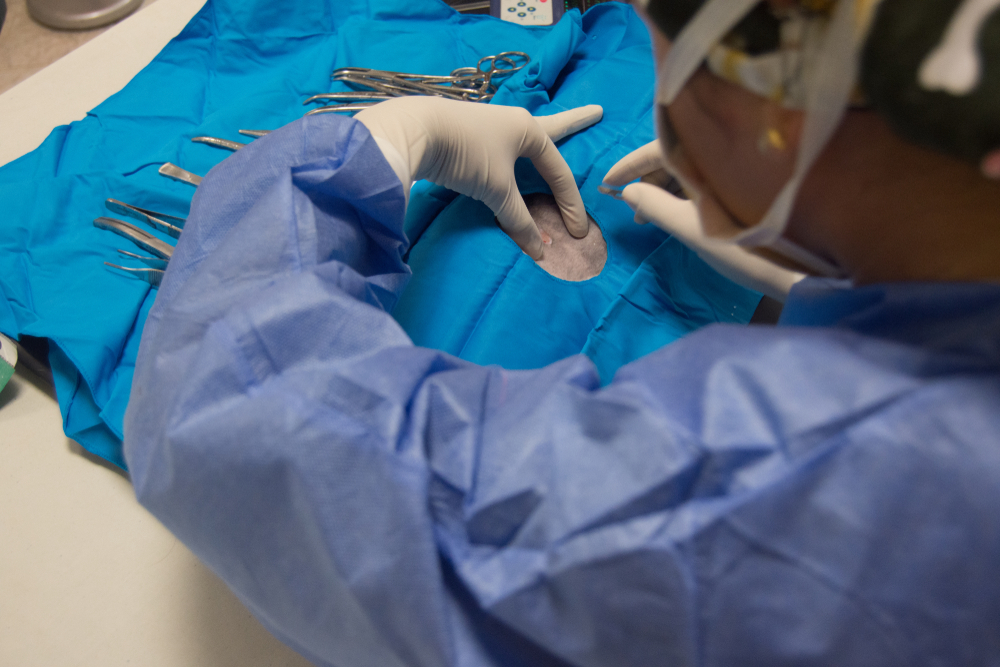Click to Skip Ahead
Spaying your dog is a big decision; although common, it’s a major surgery. However, it’s ideal for most dogs since it prevents unwanted pregnancies and reproductive problems in the future. So how long does a spay take? A female dog spaying procedure takes between 20 and 90 minutes, depending on the age, size, and heat cycle of the dog.1 Female dogs in heat can take longer because their reproductive tract has a prominent blood supply and is more delicate.
Spay Surgery
Spaying is the common name used for ovariohysterectomy, a surgical procedure that removes the uterus and ovaries to sterilize a female dog and prevent reproduction. Some vets will perform an ovariectomy, which just removes the ovaries, but it’s not as common. A spaying surgery is performed under general anesthesia, so your dog will be asleep. Her heart rate and respiration rate will be monitored closely throughout the procedure.
Typically, the vet will run bloodwork before surgery to check your dog’s organ function and ensure she’s healthy enough for anesthesia. Before the anesthesia, your dog will receive a sedative to reduce anxiety and pain. Then, your dog is put under anesthesia, and the abdomen is clipped to prepare for surgery. When ready, an incision is made through the skin of the abdomen. Depending on your dog’s size, this incision can be big or small. The vet will use a spay hook to find the uterus and bring it out of the abdomen.
The ovaries are clamped off with a surgical tool, and the vet ties off each ovary and removes it with a scalpel. Depending on the technique used, the uterus may be left in the abdomen or may be removed. If everything goes well, the vet will close the abdomen with sutures beneath the skin, which dissolve on their own, and staples or sutures on the skin. These may need to be removed after recovery, which gives your vet an opportunity to check the incision.
Your dog will be given pain medication and allowed to wake up, which may take 20 minutes to an hour. Most dogs can go home on the day of the surgery, but your vet may wish to keep your dog overnight or longer.

Spaying Post-Operative Recovery and Complications
Spays are common surgeries that typically have no complications. The risks include pain, infection, excessive bleeding, and opening of the surgical site. Anesthesia also has risks, including death, which is why it’s important to get a pre-surgical examination and bloodwork. Most dogs recover from a spay with no issues, but following the post-operative instructions is important.
Your dog will probably need a dog cone, e-collar, or pillow collar to prevent her from licking or biting at the staples or sutures, which can cause infection or opening. Her activity will also be restricted to leash walks and rest for one to two weeks following surgery. A little discomfort is normal and can be managed with pain medication. Excessive pain, swelling, redness, heat, odor, or discharge from the incision could indicate a problem.
Complications usually arise from a dog licking or biting the surgical site. If you have any concerns, contact your vet.
To talk to a vet online now, click on the image or button below:
Benefits of Spaying
Spaying a female dog prevents overpopulation, which is why most shelters and rescues spay female dogs before adopting them out. Removing the ovaries and uterus not only eliminates pregnancies but also prevents the heat cycle and the hormone fluctuations that go along with it.
When females go into heat, they can experience an urge to roam and find a mate. They may also become more vocal during this period and bark or whine. Most females are good at keeping themselves clean, but a dog in heat can leave bloody discharge around.
There are numerous health benefits to spaying as well. Spaying at the appropriate time can prevent a potentially deadly and painful uterine infection called pyometra, as well as uterine and ovarian cancers. Studies show that female dogs spayed before their first heat cycle have a 0.5% chance of developing breast cancer. Spayed dogs also generally live longer than their intact counterparts.
Conclusion
Spaying female dogs is generally recommended for their health benefits and advantages. Female dogs that are spayed at an appropriate age are at a lower risk for reproductive problems and cancers, as well as dangerous behaviors like roaming in search of a mate. Spaying also prevents unwanted litters and helps with the overpopulation of dogs in animal shelters and rescues.
See Also:
Featured Image Credit: SeventyFour, Shutterstock














